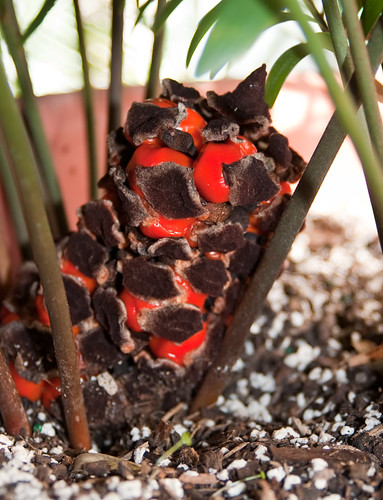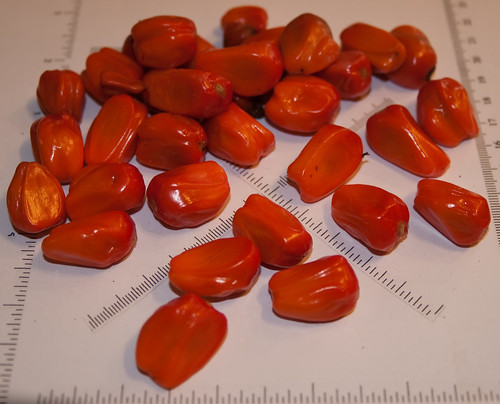Page 1 of 1
How to tell when female cones are receptive?
Posted: Tue Jan 25, 2011 11:44 am
by Knnn
Have a
Zamia floridana (wide leaf, "Palatka Giant") coning, does anyone know how to tell when the cone will be receptive to pollen?
(and does anyone have any pollen?


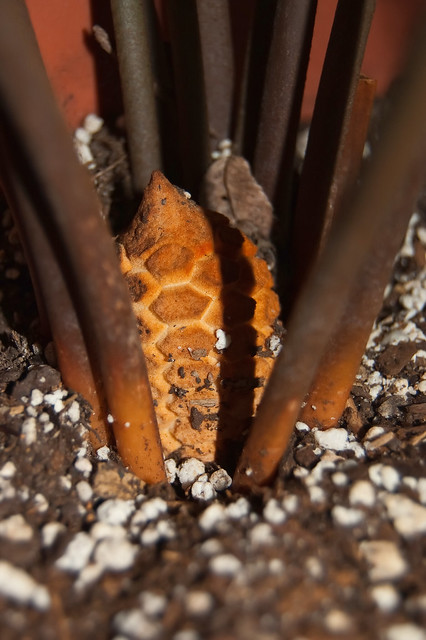
Steve
Posted: Tue Jan 25, 2011 3:39 pm
by lucky1
Well done, Steve! Gorgeous cycad.
Sounds like a drop of liquid is the clue to readiness:
second paragraph here:
http://books.google.ca/books?id=Cqor3as ... ve&f=false
By the way, can pollen survive sub-freezing shipping temperatures?
Barb
Posted: Tue Jan 25, 2011 4:11 pm
by Knnn
Barb,
Thanks for the link! I have about 20 packages of
Zamia vazquezii pollen in my deep freeze.
Here's the article that explains the procedure
http://www.plantapalm.com/vce/horticulture/pollen.htm
Not sure if I can cross them, but good practice if nothing else

Steve
Posted: Tue Jan 25, 2011 4:15 pm
by Cameron_z6a_N.S.
Hi Steve,
You might want to try posting this one on PalmTalk, I believe there is a small group of people on there who have/exchange cycad pollen!
Cameron.
Posted: Tue Jan 25, 2011 4:36 pm
by lucky1
Also, recall reading on RPS that they buy pollen...

Posted: Wed Jan 26, 2011 7:01 am
by Knnn
Cameron, Thanks for the suggestion, I'll check it out.
Barb, These are common, probably not much of a market.
One of my goals has been to get a couple of small breeding colonies going. A couple more new plants this season and I should be just about there

Steve
Posted: Wed Jan 26, 2011 7:09 am
by lucky1
In order to keep cross-pollination and hybridization occurring, do you have to isolate cycad species in separate areas?
Re: How to tell when female cones are receptive?
Posted: Wed Jan 26, 2011 3:55 pm
by virtualpalm
Knnn wrote:Have a
Zamia floridana (wide leaf, "Palatka Giant") coning, does anyone know how to tell when the cone will be receptive to pollen?
(and does anyone have any pollen?

Steve
Steve, my Palatka Giants are coning now as well. One of my males has two elongating cones that should be dropping pollen in the next day or two.

I would be happy to collect some pollen, dry it, and send it to you. Sending fresh pollen to a cold climate this time of year would not be good, but if it is dried the cold will not affect it.
As for determining when the cone is receptive, the macrosporophylls (cone scales) will crack open revealing spaces betwteen them -- like in the photo below.

I apologize for the poor quality of the photos. I took them with my iPhone in the dark just now. If you want better photos of a receptive cone I'll try to get a better one tomorrow.
Jody
Posted: Wed Jan 26, 2011 3:56 pm
by virtualpalm
Knnn wrote:Cameron, Thanks for the suggestion, I'll check it out.
Barb, These are common, probably not much of a market.
One of my goals has been to get a couple of small breeding colonies going. A couple more new plants this season and I should be just about there

Steve
Actually, the true Palatka Giant coonties are not that common. I am happy to hear that you are building some breeding colonies.
Jody
Posted: Wed Jan 26, 2011 4:02 pm
by virtualpalm
lucky1 wrote:In order to keep cross-pollination and hybridization occurring, do you have to isolate cycad species in separate areas?
You would only need to isolate plants in areas that have natural pollinators, and even then you would have to go to pretty extreme lengths to prevent the natural pollinators from getting to the female cones. Here in south Florida we have the natural pollinator of the coontie that is native to here as well as the pollinator of
Zamia furfuracea from Mexico that came in on wild-collected plants many years ago. Thus, it would not be a good idea to try to build breeding colonies of Caribbean or Mexican zamias in this area. People in South Africa have similar problems with cross-pollination in various
Enephalartos species.
As a side note, the
Zamia pollinator from Mexico also pollinates cones of
Dioon spinulosum on occasion here in south Florida.
Jody
Posted: Wed Jan 26, 2011 4:42 pm
by lucky1
So the pollinator would likely create a hybrid between Dioons and Zamia? or not between species.
I can imagine a whole bunch of eye-popping hybrids...tall Z. spinulosum ?

Barb
Posted: Wed Jan 26, 2011 5:18 pm
by virtualpalm
lucky1 wrote:So the pollinator would likely create a hybrid between Dioons and Zamia? or not between species.
I can imagine a whole bunch of eye-popping hybrids...tall Z. spinulosum ?

Barb
Hybrids between species, yes, but not between genera... sorry!
Jody
Posted: Wed Jan 26, 2011 8:31 pm
by lucky1
Well, I tried

Thanks Jody.
Posted: Thu Jan 27, 2011 6:57 am
by Knnn
Jody, Great info and photos, now I know what to look for!
Thanks too for the pollen offer, sent you a PM.
Steve
Posted: Thu Jan 27, 2011 7:10 am
by lucky1
Steve
Keep the camera nearby for the process please.
Barb
Posted: Sat Jan 29, 2011 9:03 am
by virtualpalm
Here are a couple new photos from today. I harvested these two male cones.


Jody
Posted: Sat Jan 29, 2011 9:52 am
by lucky1
Spectacular photos, Steve.
They look like they're glowing

Posted: Sun Jan 30, 2011 6:30 am
by Knnn
Jody, Great looking male/female cones

Barb, I'll get some photos as I attempt this....
(Think I've reached my upload limit on Flickr, need to wait until it resets

Steve
Posted: Sun Jan 30, 2011 7:50 am
by lucky1
Sorry! Great pics Jody.
Steve, there's no limit on a paid Flickr "pro" account (unless that's changed since Yahoo bought them).
Flickr had some burps recently, might be that.
Barb
Posted: Sun Jan 30, 2011 4:25 pm
by Knnn
Barb, I'm back to the "free" account

Jody's photos are a great comparison of the characteristics between male/female cones.
Steve
Posted: Sun Jan 30, 2011 5:25 pm
by lucky1
The picture makes the cones resemble garden lights...
great comparison of the characteristics between male/female cones.
Certainly is...now if you two could get those plants in the same area...harvest of viable seeds.
Barb
Posted: Mon Jan 31, 2011 7:59 pm
by virtualpalm
Barb, I think I mentioned in a previous post that my female sets seeds naturally almost every year. The native coontie pollinator does the work for me, and since I don't have any other Caribbean zamias in my yard that cone at the same time and there aren't any other zamias anywhere in my neighborhood that I know of, I am pretty confident that the seeds are pure Palatka Giant even though they are open pollinated. If anyone is interested in seeds from the female cones in the photo, feel free to contact me toward the end of this year and I'll let you know about this year's seed set.
Jody
Posted: Tue Feb 01, 2011 9:07 am
by lucky1
I'm certain there's a ready market for those, Jody.
RPS is likely waiting at your door...

Good luck with them.
Barb
Posted: Wed Jun 01, 2011 7:49 am
by Knnn
Just a follow up...................
The weather turned cold after the cone emerged, and it was at least another 6-8 weeks before it became receptive.
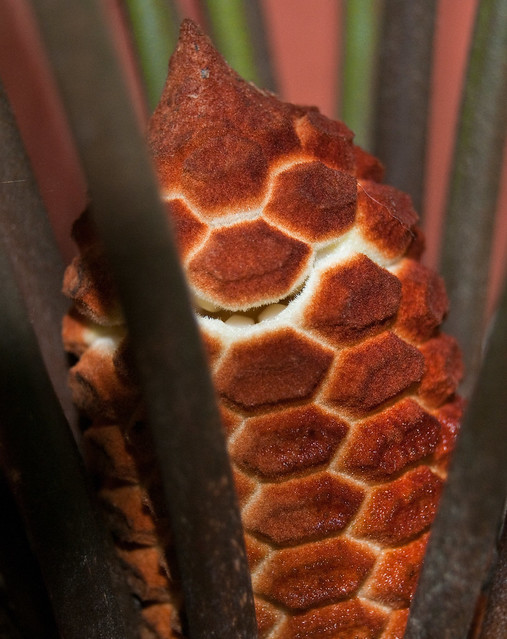
Thanks to Jody for sending me pollen! Applied 3 times using a brush every other day.

The cone has since closed and seems to be growing in size, so hopefully success?
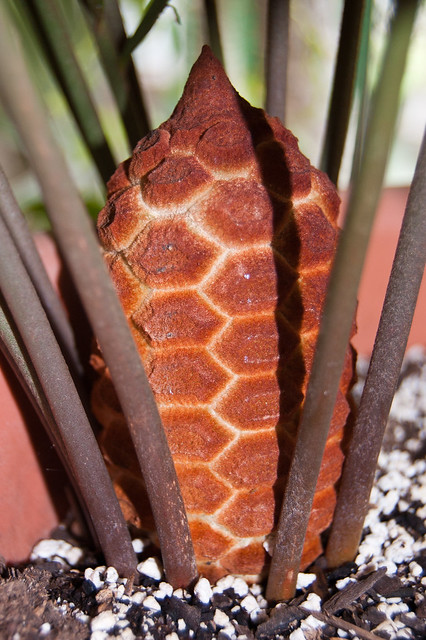
Steve
Posted: Wed Jun 01, 2011 1:13 pm
by lucky1
Wow, Steve, congratulations.
A swelling cone probably means gestation? (or whatever it's called)
It'll be neat to see what happens next and when.
Barb
Posted: Thu Jun 02, 2011 4:07 pm
by virtualpalm
Steve, I wish you luck with your pollination. However, without the pollen being injected into the inside of the cone, the chances are pretty slim. I use the wet method on all zamias, simply suspending the pollen in a small amount of purified water and injecting the liquid into the spaces between scales with a curved-ended syringe. Hopefully there was enough air movement (or possibly insect movement) to carry some of the pollen into the cone.
Jody
Posted: Wed Jun 08, 2011 7:25 am
by Knnn
Barb, This is all new to me too, I think something is happening, not sure what

Jody, I noticed as the cone became fully receptive it opened on the top and bottom. Seemed like an open invitation for pollinators to crawl through.
Had a little bit of pollen left over that I did mix with water and inject into the top of the cone.
Whether successful or not, this has been a great learning experience

Steve
Posted: Wed Jun 08, 2011 10:18 am
by lucky1
Intricate details.
Mother Nature's got it all figured out.
Good that you're hedging your bets Steve.
One of the two methods will surely succeed.
Looking forward to updates.
Barb
Posted: Thu Jun 09, 2011 5:25 pm
by Knnn
Here's a recent photo,
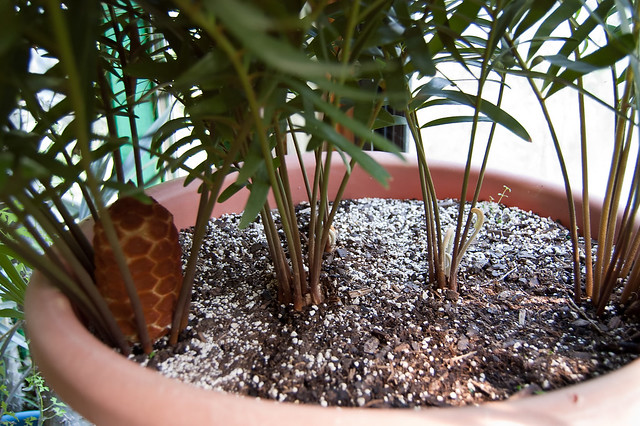
Also noticed a cone emerging on a Zamia sp. "Mexico", started these from seed about 4 years ago.
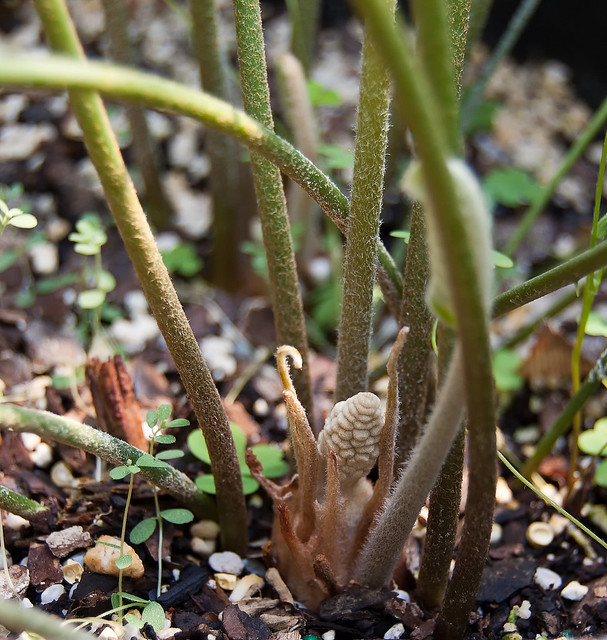
Steve
Posted: Thu Jun 09, 2011 7:40 pm
by lucky1
Good to see yours respond, Steve, with all your heat (and water).
Mine are croaking.

Barb
Posted: Tue Jan 24, 2012 2:59 pm
by Knnn
Not too much longer now, seeds are just about ready


Steve
Posted: Tue Jan 24, 2012 9:15 pm
by lucky1
Incredible beauty that Mother Nature creates!
At first glance, Steve, those cones always remind me of lava erupting from a volcano.

How's your pollen storage project going?
Barb
Posted: Wed Jan 25, 2012 8:27 am
by Knnn
Hi Barb,
I'm happy to see the results!
Have plenty of Zamia vazquezii pollen in the freezer, now all I need is a female plant

Steve
Posted: Wed Feb 15, 2012 2:12 pm
by Knnn
Posted: Wed Feb 15, 2012 2:30 pm
by lucky1
Beautiful seeds, Steve.
Since I didn't pay much attention in Botany (or Biology for that matter), the progeny would be F1 hybrids?
And how would you "write" the name of the seedlings?
Barb
Zamia
Posted: Fri Feb 24, 2012 7:19 pm
by chumleycycads.com
Looks familiar.















